---Postal officer, Son, Brother, Uncle, Hero---
Birth and Parents
Alec Ernest James BELL was born on the 28 March 1946, the second youngest of six children to Robert Edward Arthur and Florence Rose Elizabeth (nee JONES) BELL. Robert Bell a fitter and turner was employed by Western Australian Government Railways at the tram depot, colloquially referred to as the ‘Carbarn’, that was located at the East Perth end of the Causeway. Prior to her marriage in 1933, Florence had worked in the tailoring trade and was a skilled seamstress, skills she would need raising a family in the Depression and war years. In the early days the Bell family lived in Channon Street, Welshpool.
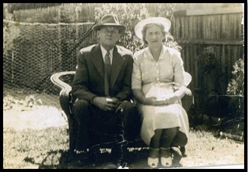
Robert Edward Arthur and Florence Rose Elizabeth BELL, dressed for a family wedding, posed in the backyard of the Bell family residence, 953 Albany Highway, East Victoria Park. Courtesy of Janet McWhirter.
Early Life
In 1939, the Bell family of then six, moved into their forever home at 953 Albany Highway (on the corner with Camberwell Street), East Victoria Park. It was a Federation style, two-bedroom, double-brick and iron house with a wide front verandah. It was still standing in the early 2000s but no longer.
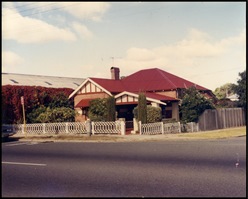
The Bell Family residence, 953 Albany Road, East Victoria Park. Courtesy of Janet McWhirter (nee Bell).
Conveniently the trams and later the buses stopped outside the door of the family home, making it easy for the family to travel where they needed to go and also for Robert Bell to get to work at the Carbarn.
Alec and his siblings had a happy and adventurous childhood as described in memoirs shared by Alec’s oldest sister, Margaret Graham: “My parents, not unlike their many counterparts, experienced the depression and war years in the 1930’s. Ordinary persons who lived in extraordinary times, raising their families to be enterprising, resourceful and to enjoy life. Life is a wonderful journey… We were introduced to the simple joys of life through the combined efforts of our parents. We experienced varied and numerous outlets for our high spirits. Camping expeditions to Coogee beach, crabbing and relaxing on the foreshore of the Swan River, Causeway area. Hiking and scouring the hillsides on many picnics, riding the trams, trains and ferries. Delighting in the old fairgrounds and Como beach with bumper cars, sideshow alleys etc.” [1]. The backyard of the family home was filled with dogs, kittens, chickens, children playing and even ducks at one stage, Margaret recalls[2], that the garden never thrived with all the antics and action it was succumbed to, but much joy was had and the family never ran out of eggs.
Margaret’s memoirs also include some photos of young Alec playing with dogs and scooters in the backyard and he and his sister Janet playing with kittens. Unfortunately the images aren’t very clear as they are from photocopies, but they still provide a glimpse into the backyard fun and antics that Alec and his siblings enjoyed growing up at their home on the corner of Albany Highway and Camberwell Street, East Victoria Park.
|

Alec Bell on an old scooter with 'Taffy', circa early 1950s.
Courtesy of Margaret Graham (nee Bell)
|
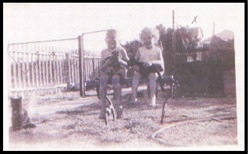
Alec and Janet Bell (later McWhirter) with kittens in the backyard of their family home, circa 1950.
Courtesy of Margaret Graham (nee Bell)
|
One wonderfully delightful memory of childhood and sibling frivolity that Margaret shares, paints a beautiful picture of Bell family life:
“Our washlines were about three, strung across the back yard, and attached to poles at either end. They were lowered and raised on a pulley system, and the prop (poles) were positioned at the end, and in the middle, to support the weight of the washing, to stop it from falling on the ground.
“As we grew older, we assisted my mother in this chore. My young brother Alec, loved to play, and on one occasion he pestered me to play with him. In the end I grew tired of his demands and pegged him on the line by the braces of his overalls. He was a little ‘tyke’, and I swung him along the line, supporting his legs as we went. He loved it, and it became a common occurrence after that to swing him along as I hung the washing. Alec would exclaim excitedly, ‘Please Margie peg me to the line’ " [3]
One can just imagine a little boy pegged from his overalls and swinging down the clothesline with a grin on his face that would make the sun envious.
|
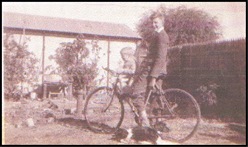
John and Alec Bell sitting on a bicycle with 'Pip' the dog resting on the ground, circa early 1950s. In the backyard of 953 Albany Highway, East Victoria Park.
Courtesy of Margaret Graham (nee Bell)
|
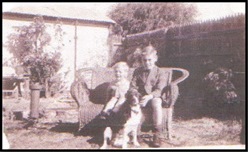
Ric and Alec Bell with 'Pip' the dog, circa early 1950s.
Courtesy of Margaret Graham (nee Bell).
|
School Days
Alec went to primary school at Our Lady Help of Christians School, East Victoria Park. His secondary schooling was undertaken at St Francis Xavier College, now part of Ursula Frayne Catholic College. Xavier College was started by the Christian Brothers in 1954 and was situated near Our Lady Help of Christians School. Alec attended school until 1961 when he had finished the 10th grade and was aged 15 years and 9 months.
|
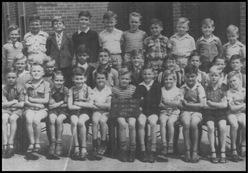
|
Students at Our Lady Help of Christians School, East Victoria Park 1954, Alec is in the middle row, first on the left.
Courtesy of Neville Brown JP.
|
Working Life
Alec started working for the Postmaster General’s office around 1962. He worked first at the local post office in East Victoria Park as a telegraph boy and later as a postal officer at the GPO, in Perth.
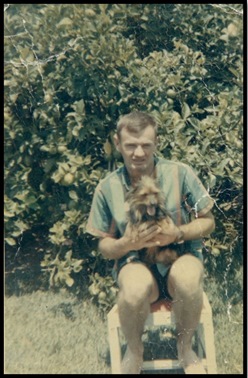
Alec Bell aged about 19 with 'Timmy the Terror', in the backyard at 953 Albany Highway, the Bell Family residence.
Courtesy of Janet McWhirter.
War Service
Prime Minister, Sir Robert Menzies, on the 10 November 1964, announced the introduction of a “selective National Service scheme from mid-1965. It was designed to bring the size of the Regular Army from 22,750 to 37,500 and also to expand the Citizen Military Forces. The scheme chose future soldiers by ballot.” [4]
Private Alec Ernest James Bell (Service Number 5714453) was called up in the National Service Scheme on 13 July 1966 and went to his initial training as part of the 2nd Recruit Training Battalion in Puckapunyal, Victoria. By the 8 September 1966 Alec was undertaking training with the 3rd Infantry Training Battalion based in Singleton, New South Wales. This training was the basic rifleman training which usually takes around a year to complete. Alec undertook about six months of training only (leave time extra) before he was sent to Vietnam.
Private Alec Bell undertook training as a stretcher bearer which meant he would be required to take up the role of unofficial platoon medic. From all reports there was very limited training given to riflemen/stretcher bearers. Bob Stumer, the company medic for 6th Battalion RAR noted in an interview in 2003 for a University of New South Wales project on Australians at War, that stretcher bearers, who were the unofficial platoon medics, as there were only officially doctors, company medics, and then the stretcher bearers at the platoon level. In his interview, Bob Stumer who was a company medic states that stretcher bearers received very basic training: “Well you did a first aid course plus a little bit extra, that’s about it. First aid course and a little bit extra” [5]. Mr Stumer goes on to say in his interview that the role of the stretcher-bearer was often in the absence of the company medic, to treat anything and everything, and the following account from Mr Stumer provides a good sense of what also faced Private Alec Bell in his role as rifleman/stretcher-bearer for 2 Platoon A Company 7 Battalion RAR:
“[Interviewer asks Mr Stumer] So as a stretcher-bearer, what was outlined to you would be your role once you got to Vietnam? [Mr Rob Stumer] Well my role as a stretcher-bearer was with the platoon and I had to if the medic wasn’t available, well it was up to the stretcher-bearer to treat anything and everything.
“He had to do his best. And the medic would arrive as soon as possible. And yes he would treat anything from minor things to big things. And you carried a medical kit with you as well. The kit was about so size, and you would have it strapped over the top and that was extra.
“And being rifle section leader I also had the claymore as well, so that weighed quite a bit more than the medical kit though. And my duty was first rifleman, and second stretcher-bearer. That’s the way I looked at it. We had to do the duties of a medic if there was no one available.” [6]
An interview conducted with retired Major Harold Butterworth in 2004 also for the ‘Australians at War’ project by the University of New South Wales, also supports the assertion that the whole 7th Battalion was short-changed on the usual training time:
“All the bands people, they are all in the medical platoon. The medical platoon is the biggest platoon in the battalion, and all the bandies become stretcher bearers. 7 RAR didn’t have a band, but we had a group of people who were stretcher bearers, all of whom were National Servicemen. They were a good group of people, but they weren’t musicians.
“In the other battalions they were musicians. They’re soldiers first, musicians, stretcher bearers and as such that’s part of their trade. So they had already been first aid trained and they are part of the medical team. The doctor comes in and gives them lectures, and the RAP [7] sergeant teaches them, and each of the companies has a stretcher bearer with the medic, so you become a close knit team. Our team never had a chance to become that, because we picked up a company of people on the way to one of these exercises, came back, went on pre-embarkation leave and then went to Vietnam. I was teaching a lot of these stretcher bearers first aid on Barrawinga, one of the exercises at Shoalwater Bay, and it was unsatisfactory really. They were keen to learn, but it was the time factor of putting them into situations that just simply weren’t there.” [8]
By 7 December 1966, Alec joined the Battalion in which he would serve with 1,183 others, they were the 7th Battalion Royal Australian Regiment (RAR). Interestingly over half of the Battalion’s contingent, numbering 664 men, was made up of National Servicemen [9].
For the Victoria Park record books it is also interesting to note that during the time that the National Service programme ran from 1965 to 1972 there were 250 young men conscripted from the areas within the Town of Victoria Park for service. Of those 250, ten died – four overseas and the balance in Australia. The four who died overseas were Private Alec Bell, Private Christopher Roost and Corporal Paul van Rijsewijk who served in Vietnam. The fourth local National Serviceman to die overseas was Des Gibson who died in Singapore while serving in Malaya.
|
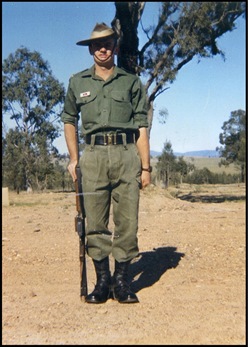
Private Alec Bell at training, believed to be at Puckapunyal, Victoria, 1966.
Courtesy of Jane McWhirter.
|
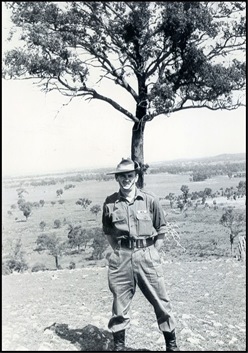
Private Alec Bell at training, also believed to be at Puckapunyal, Victoria, 1966.
Courtesy of Janet McWhirter.
|
|
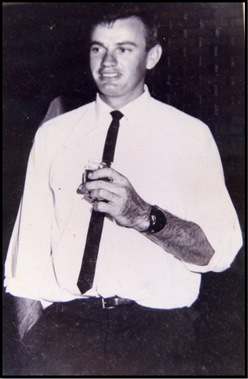
Alec at his 21st Birthday Party.
Courtesy of Janet McWhirter.
|
In March 1967, Alec turned 21 years old, and a party was hosted by his brother, John Bell in Kewdale to celebrate the milestone occasion. Alec was a Private in the 7th Battalion RAR, ready to deploy to Vietnam in the early days of the very next month. Four of his siblings were already married, and three of these had children, but Alec was not married.
Around this time the family took special pictures with Alec around a beloved lemon tree in the backyard of the family home at 953 Albany Highway. Both Margaret and Janet Bell have recorded how much this tree was prized by their father Robert all throughout their growing years. Robert Bell would meticulously cultivate compost from kitchen scraps to feed and tend the lemon tree and grape vine, he even used to recycle the bath water after the children had washed and carried the water to “his beloved lemon tree.”[10]
|
|
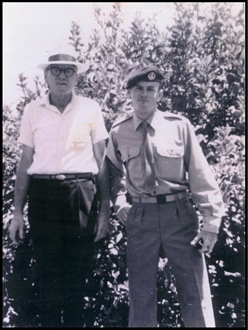
Robert and his son, Private Alec Ernest James Bell in front of the family's lemon tree.
Courtesy of Janet McWhirter.
|
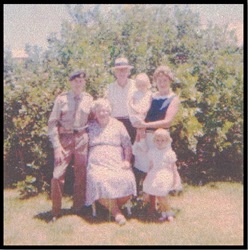
Family group in front of the lemon tree - Alec Bell, Robert Bell, Margaret Graham (nee Bell) standing at back, Margaret holding her daughter Robyn with her other daughter Margaret standing at her feet. Florence Bell is seated with her arm around her beloved youngest boy.
Courtesy of Margaret Graham (nee Bell) [11]
|
|
On the 8 April 1967, Private Alec Bell embarked for Saigon, South Vietnam onboard the HMAS Sydney (III). The ship would sail 25 voyages to and from South Vietnam between 1965 and 1972, so many, that the ship earned the nickname of the ‘Vung Tau Ferry’ [12]
Private Alec Bell’s service record indicates he was a rifleman in 2 Platoon, A Company, 7th Battalion Royal Australian Regiment. He disembarked at Vung Tau, Vietnam on 20 April 1967.
The soldiers’ days generally involved a lot of drudgery, walking for hours through mud and muck, reconnaissance work and never quite knowing from where the enemy may appear. As O’Brien quotes Lieutenant N. J. Clark of the Royal Australian Artillery, in his published history of the 7th Battalion RAR in Vietnam: “For this was guerrilla warfare, this was Vietnam, weeks of trudging and then a contact of a few seconds, over almost before it began”[13].
Private Alec Bell was serving as a platoon medic and he was known for his compassion and care for his mates, although family story tells it, that he did not have too much sympathy for soldiers who suffered now and then from a hangover after a rowdy night, he would give them some aspirin and tell them to carry on. A photograph in the Australian War Memorial [14] depicts some of the tasks that platoon medics were responsible for during Australia’s involvement in Vietnam. The photograph shows Private Alec Bell checking a young Vietnamese Montagnard boy for fever. “The check up was part of a village Medical Civil Aid Project (MEDCAP), carried out by 7th Battalion, …Royal Australian Regiment” [15].
|
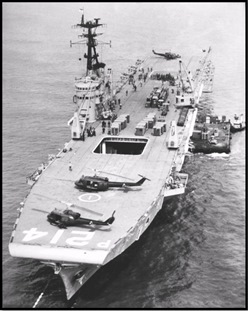
HMAS Sydney (III). Courtesy of the Royal Australian Navy
|
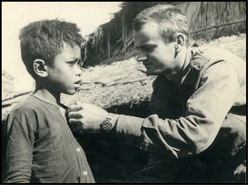
Private Alec Bell checking a young Vietnamese Montagnard boy for fever.
Courtesy of the Australian War Memorial and Janet McWhirter.
Ian Maxwell Garthwaite, ex-Platoon Commander of 2 Platoon, A Company, 7th Battalion RAR takes up the story of Private Alec Bell’s service as a platoon medic in a speech given in March 2015 at the official opening of Alec Bell Park:
“5714453 Private Alec Ernest James Bell was a National Serviceman conscripted for service in South Vietnam. He served as an Infantry platoon medical orderly in the Second platoon, A Company of the 7th Battalion, Royal Australian Regiment.
“I was in 2 Platoon with Private Bell from 8 August 1967 until the 10 November 1967. In the time-honoured tradition of the services, Alec Bell was immediately nicknamed ‘Dinga’.
“ ‘Dinga’, as Platoon Medic was a busy and valued soldier with a weighty responsibility on his shoulders. In battle his duty was to give initial first aid to soldiers wounded in the fight. His actions literally meant the difference between life and death for his comrades. Private Bell took this responsibility most seriously. The moment he donned his medical kit, he was ready to go forward in the middle of a fire fight to help a mate in trouble. When the cry of ‘Medic’ cut through the deafening noise of rifles, machine guns and the ear-splitting crash of artillery, Alec was the man you wanted to see, running or crawling towards you, lying beside you, bringing an end to pain, stopping the bleeding, reassuring you that you would be drinking beer in the soldier’s boozer in a few days time. His courage under fire was well known in the platoon.
“When I first met Alec in August 1967. He was competent and feisty. As a National Serviceman, he regarded his time in the Army as a necessary evil and a definite drop in status. He epitomised the Nasho’s [16] creed, “I came to the Army to do a job, not to get one!” [17]
“When not on operations, Dinga was still on duty back at Base. In the platoon, he was the first port of call for any soldier suffering from any health issues, whether it was minor cuts and wounds, blisters, fevers, skin rashes and other less talked about ailments which popped up after a rare Rest and Recreation leave to Vung Tau.
“He also treated severe hangovers after the first night back from operations. For this he dispensed aspirin and very little sympathy. As far as he was concerned this was a self-inflicted wound and a waste of his time! He occasionally had to treat himself for the same complaint. However, he never suffered from a hangover, only a reaction to stale American beer.
“Another of his duties while we were resting from operations was MedCap. This was going out to supposedly ‘friendly’ villages to examine, treat or refer villagers with medical conditions. He regarded this with both good and bad humour. He was rewarded by the noticeable improvement in his patients from one visit to another, but also maintained that half of the male patients were enemy Vietcong Army Reservists coming in for a free medical check-up with compliments of the Australian Government!
“I am personally in debt to Alec. In November 1967, our company was in a defensive position, awaiting orders for our next task. The enemy crept in to about 45 metres, set up a large directional mine, pointed it at the Company and set it off. It was 2 Platoon’s misfortune to be closest to the blast. In a split second, two soldiers were dead and ten on the ground wounded. I was one of them.
“I was down, unable to do anything except shout helpful advice. I was also sh*? scared. Then Alec Bell hurried by, caught sight of me and said ‘What’s up Boss, you alright?’; [I replied] ‘No, I’ve been hit’; [Alec said] ‘Let’s have a look, - Oh, we’ll soon fix that’. He quickly and expertly applied a shell dressing over the wound, examined his work and then said ‘Hm, I’d better put another one on.’ Which he did. Then he said ‘Sorry Boss, gotta go there’s lots of others to fix’ and left me. That was the last time I ever saw him.” [18]
Private Alec Bell carried on his duties consistently and admirably right up to the end on the fateful day of 29 January 1968. During Operation Coburg in Bien Hoa Province, South Vietnam, O’Brien in his official history of the 7th Battalion RAR describes the day’s events and what were to be the last hours of Private Alec Bell’s life:
“At 1615 hours on 29 January, 2 Platoon A Company ambushed a group of enemy at the same place as their contact the previous day [19]. When Second Lieutenant Brendan O’Brien had just finished giving orders for the evening, an enemy group was heard approaching the ambush. It was sprung when the first five were in the killing ground. It became evident that the enemy strength was at least 20 to 30, as the fire that was immediately returned covered the whole platoon width. The initial violent fire fight lasted about seven minutes during which time the platoon was engaged with RPG2s and 7s (which moved to the flanks and fired towards the centre of the platoon), AK47 and RPD fire. Those wounded in this first few minutes included the platoon commander, his signaller and the platoon medic. Four enemy were killed in the first few bursts of fire. The Platoon Sergeant, Tom Bourke, described the contact:
“Helicopter gunships drove the enemy off. Platoon commander and section commanders were WIA – all were Dustoff [20] casualties. The platoon had killed one enemy the previous day and one had escaped. He must have gone and fetched his mates back the next day. Morale was high. When the contact was started I was unable to hear because of rocket explosions. Only six personnel left able to defend. The Dustoff was driven off three times by enemy rocket and small arms fire. The platoon commander, although wounded, had to man the radio set as I could not hear.
“One enemy climbed a tree and directed fire until he was killed. After the first fire fight, the enemy used small arms covering fire to screen their withdrawal to the east.
“During his fire fight, Lieutenant O’Brien had called in gunships, airstrikes, mortars and artillery. He was also given assistance by the Battalion Second-in-Command, Major Alf Garland, who was airborne above the contact in a Sioux and helped the gunships to distinguish between the enemy and our troops. The enemy continued to engage 2 Platoon with small arms and M79 fire to cover the evacuation of their wounded. The first Dustoff helicopter arrived and was shot at by the Viet Cong. The Battalion Second-in-Command heard the Dustoff pilot say ‘Hell, what was that? I seem to have bitten off more than I can chew’. Major Garland replied that an RPG rocket had passed in through one door of the helicopter and out the other.
“Despite the enemy fire and with the continuing assistance of the Battalion Second-in-Command, three litter and three winch casualties were lifted off before last light. The engagement continued for two and a half hours, with the platoon employing artillery and mortars on likely enemy escape routes. It was not possible to estimate the total enemy casualties because of the dense vegetation. However, eight were seen to be killed, although only six bodies were found in a sweep conducted that evening, by which time the enemy had withdrawn. The battlefield was thoroughly cleared the next morning.
“When Sergeant Bourke [21] was asked to describe the bravest act he saw in Vietnam he wrote:
Private ‘Dinga’ Bell was platoon medic on the late afternoon of 29 January 1968. In the first few moments the Platoon Commander, 2Lt O’Brien, and all the NCOs were wounded including Private Bell who had received a direct hit from a rocket. Even though shockingly wounded, Private Bell tried to get to the other wounded. When he could not move he gave orders to another soldier as to how to help them. Even when we finally got him on to the Dustoff stretcher, Private Bell was still giving advice as to the care of the other wounded. As he was lifted up through the trees the enemy opened fire again. The Dustoff was forced to leave the area with Private Bell and stretcher hanging underneath. We later learned that he was dead on arrival at hosp[ital]”.
“It was subsequently confirmed that the enemy group was from C235. Their task was to act as scouts for the main attack on Bien Hoa airbase. 2 Platoon’s action disrupted this plan.”[22]
2 Platoon A Company 7th Battalion RAR had thwarted the scouting party of the enemy in their attempt to attack the Bien Hoa airbase, but Private Alec Bell died of wounds he received in this action. 12 men from 2 Platoon were wounded that day, but only Private Alec Bell died of those wounds [23]. Could that perhaps have been due to the courage under fire and almost reckless abandonment of his own safety shown by Private Alec Bell, as he was wounded and called out instructions for the treatment of his fellow wounded soldiers. We will never truly know for certain, but Corporal Clutterbuck and Sergeant Bourke [24], two of the wounded from 2 Platoon on that day, would go on record to note Private Alec Bell’s bravery.
Mr and Mrs Bell received a letter from Sir Phillip Lynch, Minister for the Army, on 26 June 1968 in answer to enquiries they had presumably made about the conditions in which their son had lost his life. Sir Lynch wrote: “Finally, I would again, on behalf of the Government and the Army, express my personal sympathy at the loss of your gallant son. I have read with feeling the report of his brave conduct before and after he received a mortal wound and I can assure you he died in a manner worthy of an Australian soldier”[25]
Legacy
Family story has it that there was a delay in getting Private Alec Bell’s body returned to Australia, that there was a significant cost involved which the family could not easily afford. Help was received it is believed, from the parish priest of Our Lady Help of Christians, who advocated on behalf of the Bell family. Private Alec Bell was buried in Karrakatta Cemetery in Grave KA 727 on 15 February 1968.
|
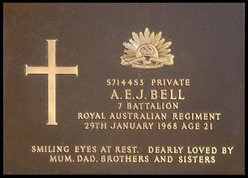
Alec’s gravestone at Karrakatta Cemetery.
Courtesy of the Nominal Roll of Vietnam Veterans
|

‘Memorial for Soldier’, article from unknown paper and date, believed to be late 1970s, to early 1980s.
Courtesy of Janet McWhirter
|
A memorial flagpole and plaque were dedicated at Xavier College in the late 1970s/1980s by the Bell family and the Korea and South-East Asia Forces Association. Due to various projects at the school the flagpole had to be moved and so did the memorial plaque. It now currently resides in a special commemorative garden at the front entrance to the Balmoral Street campus of Ursula Frayne Catholic College (formerly Xavier College).
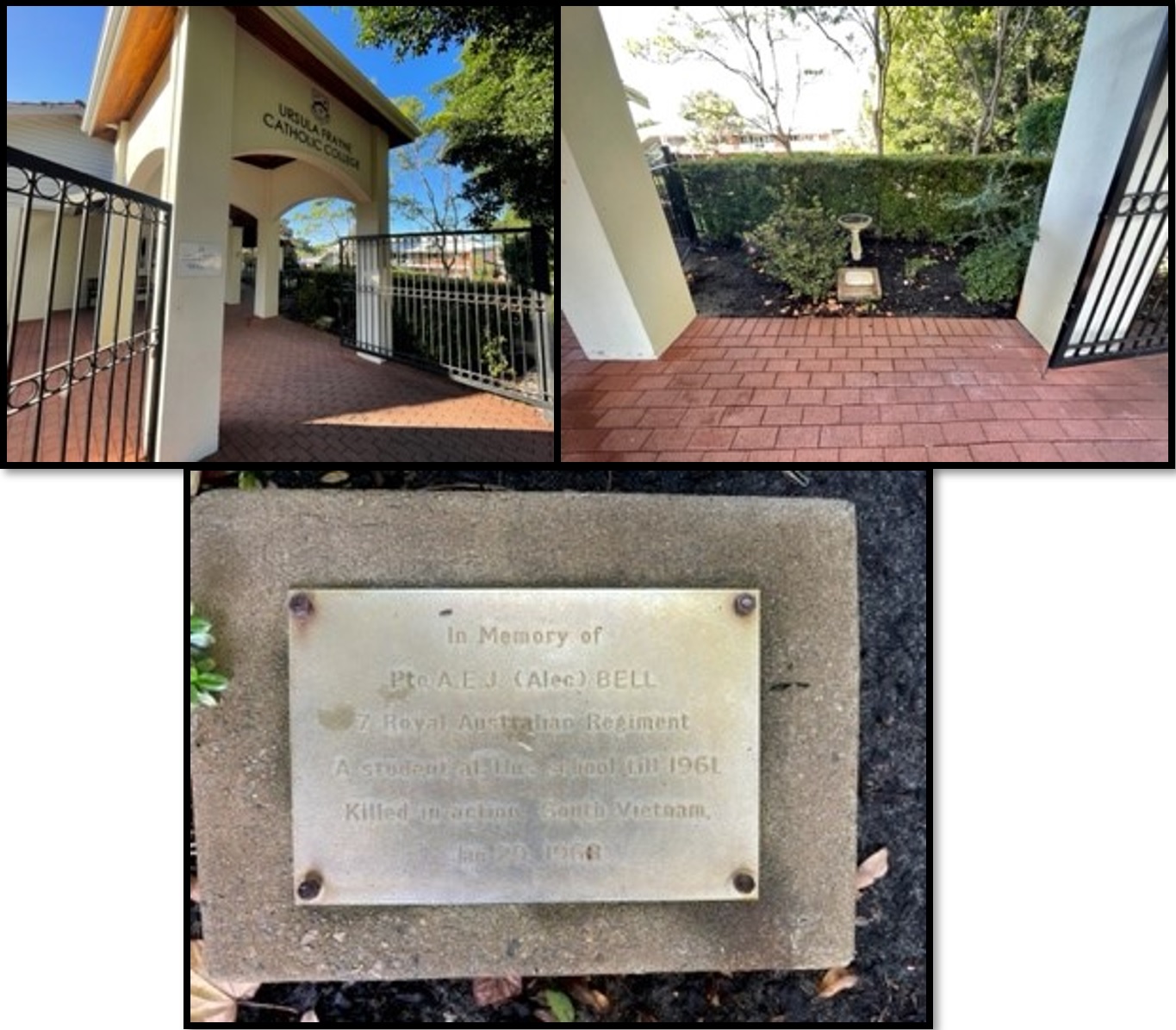
Photographs of the Balmoral Street entrance to Ursula Frayne Catholic College, East Victoria Park, with close-up of the memorial garden and birdbath, and also the plaque unveiled all those years ago by Alec's mother Florence Bell in honour of her son.
Photographs Courtesy of Ursula Frayne Catholic College.
There are other memorials to the memory of Australian soldiers killed in Vietnam, that include Private Alec Bell, such as a plaque in the Harold Hawthorne Community Hall in Carlisle. Arguably the most fitting tribute however was the renaming of a small park from Hampshire Street Reserve to Alec Bell Park. The park that is home to a children’s playground and in more recent times a Little Free Library, set-up and maintained by residents of Hampshire Street, is on the corner of Berwick and Hampshire Streets, East Victoria Park. An application for commemorative recognition for Private Alec Bell’s service and sacrifice was made by Mr Neville Browne JP to the Town of Victoria Park in 2014. The application was accepted by the Council of the Town of Victoria Park, and the reserve named Alec Bell Park on the 12 August 2014. An official opening ceremony was held at nearby Fraser Park on the 27 March 2015, with friends and relatives of Private Alec Bell in attendance, members of the 7th Battalion RAR Association and representatives of Ursula Frayne Catholic College. The school’s choir also sang at the event.
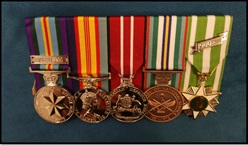
Replicas of the medals received by relatives of Private Alec Bell.
Courtesy of Janet McWhirter.
Through this glimpse into the life and times of Private Alec Bell, reports from fellow serving members of his platoon and the memories shared by friends and family, it is evident that he sought no glory or fame in his actions. Private Alec Bell completed the job he had been told to complete in Vietnam. To serve his country Australia and to care for the sick, wounded and vulnerable in the course of his duty. In his death from wounds received in action on 29 January 1968 and by his heroic act to think of others with little to no thought for his own safety, Private Alec Bell demonstrated the ultimate act of love – “Greater love hath no man than this, that a man lay down his life for his friends” [26].
Lest We Forget.

Footnotes:
[1] Graham (nee Bell), Margaret Rose Ellen 2003, A reflection of life in Victoria Park, entry into the 2003 Local History Memories Competition, Town of Victoria Park Library, East Victoria Park, Western Australia.
[2] Ibid, p. 16.
[3] Op. cit. Graham 2003, pp. 12, 18.
[4] O’Brien, Michael, 1995 Conscripts and Regulars with the Seventh Battalion in Vietnam, Allen & Unwin, St Leonards, NSW, Seventh Battalion The Royal Australian Regiment Association Incorporated, p. 8.
[5] University of New South Wales 2004, Interview with Robert Stumer, 7 May 2004, ‘Australians at War Film Archive’, Archive ID 1883, University of New South Wales, online: http://australiansatwarfilmarchive.unsw.edu.au/archive/1883-robert-stumer, accessed 17 October 2022.
[6] Ibid.
[7] RAP stands for Regimental Aid Post
[8] University of New South Wales 2004, Interview with Major Harold Butterworth, 22 July 2004, ‘Australians at War Film Archive’, Archive ID 1265, University of New South Wales, online: https://australiansatwarfilmarchive.unsw.edu.au/archive/1265-harold-butterworth, accessed 17 October 2022.
[9] Browne, Neville 2019, Soldiers Served – Vietnam – 7 RAR, unpublished research notes, compiled by the author from records of the Department of Veteran’s Affairs. Copy held by the Local History Collection, Town of Victoria Park Library.
[10] Op. cit. Graham 2003, pp. 10 & 12.
[11] Image comes from a photocopied original and is shown as clearly as possible. If you know of an original of this photo that we could borrow to scan for the Local History Collection, please get in touch with Victoria Park Library (08 9373 5500).
[12] “Between 1965 and 1972, HMAS Sydney (III) undertook 25 voyages to Vietnam and transported 16,094 troops, 5753 deadweight tons of cargo and 2375 vehicles. On her first voyage four days were taken to unload cargo in Vung Tau. On subsequent voyages this turn around time was reduced to a matter of hours.”
[13] Op. cit. O’Brien 1995, p. 55
[14] A copy was generously donated to the Local History Collection, Town of Victoria Park Library by Janet McWhirter.
[15] Australian War Memorial 1968, photograph of Private Alec Ernest James Bell, accession number: THU/68/0012/VN, online: https://www.awm.gov.au/collection/C316572, accessed 17 October 2022.
[16] Nickname for the National Servicemen.
[17] This was in contradiction to World War II, when the Depression had been so bad and men had been out of work for a long time that a ‘full-time job’ serving in the Army was a welcome opportunity and many men would have been influenced by this when volunteering to enlist.
[18] Garthwaite, Ian Maxwell 2015, Speech for the Naming of Alec Bell Park, East Victoria Park, Friday 27 March 2015, Local History Collection, Town of Victoria Park Library.
[19] “A Company had set an area ambush on a broad ridge line covering one major track and a complex of smaller tracks coming up the spur lines and leading towards the Bien Hoa airbase complex. These tracks were so well used that Major O’Donnell felt confident that some enemy would arrive before long. These tracks turned out to be one of the main enemy approach routes for the forthcoming attacks on the base. On 28 January at 1430 hours three Viet Cong entered the ambush that had been set by 2 Platoon A Company … at a junction of a creek and a system of well used tracks 2km west of Nui Gang Toi. The platoon was in the valley below the rest of the company’s area ambush”. Op. cit. O’Brien 1995, pp. 111-112.
[20] “Dustoff – helicopter evacuation of wounded”. Op. cit. O’Brien 1995, p. 284.
[21] Platoon Sergeant Tom Bourke was a highly experienced soldier. When questioned by Neville Browne JP in 2019 about comments made in an interview of the same year for a Defence Honours and Appeals Tribunal Team, Tom was asked: [Question by Neville Browne, in writing:] “Did Alec when carrying out the duties of ‘medic’ did Alec always or sometimes put the treatment of the injured before his own personal safety and well being regardless of the risk or situation? [Sergeant Bourke answered] Always [and signed this statement. [Browne had added a space for extra] “comment if you wish [and Sergeant Bourke wrote] On many contacts Alec was always straight up the front asking if we had any wounded. At that time I had served three times in Malaya and two times in Borneo. I had seen some good medics. Alec was the best I have served with, unfortunately it cost him his life. [the statement is signed by Sergeant Bourke]”. Op. cit. Browne 2022 ‘Unpublished research and notes on Private Alec Ernest James Bell’.
[22] Op. cit. O’Brien 1995, pp. 112-113.
[23] Browne, Neville (JP) 2022, ‘Casualties – 2 Platoon A Coy 7 RAR – Operation Coburg – 29th January 1968’, from ‘Unpublished research and notes on Private Alec Ernest James Bell, compiled by Neville Browne’, copies generously donated to the Local History Collection, Town of Victoria Park Library.
[24] As referenced in aforementioned quotation from O’Brien 1995, pp. 113.
[25] Op. cit. Browne 2022.
[26] John 15:13 (The Holy Bible, King James Version).
References:
Australian Electoral Commission 2012, Referendum dates and results, Australian Government, online: https://www.aec.gov.au/elections/referendums/referendum_dates_and_results.htm, accessed 17 October 2022.
Australian War Memorial 1968, photograph of Private Alec Ernest James Bell, accession number: THU/68/0012/VN, online: https://www.awm.gov.au/collection/C316572, accessed 17 October 2022.
Browne, Neville (JP) 2019, Soldiers Served – Vietnam – 7 RAR, unpublished research notes, compiled by the author from records of the Department of Veteran’s Affairs. Copy held by the Local History Collection, Town of Victoria Park Library.
Browne, Neville (JP) 2022, ‘Unpublished research and notes on Private Alec Ernest James Bell, compiled by Neville Browne’, copies generously donated to the Local History Collection, Town of Victoria Park Library.
Garthwaite, Ian Maxwell 2015, Speech for the Naming of Alec Bell Park, East Victoria Park, Friday 27 March 2015, Local History Collection, Town of Victoria Park Library.
Graham, Margaret Rose Ellen (nee Bell) 2003, ‘A Reflection of life in Victoria Park’, Entry into the 2003 Town of Victoria Park Library Local History Memories Competition, Local History Collection, Town of Victoria Park Library.
McWhirter, Janet 2022, informal discussion with Alec’s youngest sister in the Local History room of the Town of Victoria Park Library, 21 September 2022.
National Museum of Australia 2022, Defining Moments: Conscription Referendums, National Museum of Australia, online: https://www.nma.gov.au/defining-moments/resources/conscription-referendums, accessed 17 October 2022.
O’Brien, Michael, 1995 Conscripts and Regulars with the Seventh Battalion in Vietnam, Allen & Unwin, St Leonards, NSW, Seventh Battalion The Royal Australian Regiment Association Incorporated.
7th Battalion Royal Australian Regiment Association website, online: http://7rar.asn.au/wp/, accessed 7 October 2022.
Straczek, Jozef, ‘Naval Operations in Vietnam’, Royal Australian Navy, online: https://www.navy.gov.au/history/feature-histories/naval-operations-vietnam, accessed 17 October 2022.
University of New South Wales 2004, Interview with Robert Stumer, 7 May 2004, ‘Australians at War Film Archive’, Archive ID 1883, University of New South Wales, online: http://australiansatwarfilmarchive.unsw.edu.au/archive/1883-robert-stumer, accessed 17 October 2022.
Virtual War Memorial Australia 2022, ‘Alec Ernest James (Dinga) Bell’, online: https://vwma.org.au/explore/people/654207, accessed 11 October 2022.
|
This article was first published in the Victoria Park Dictionary of Biography, Town of Victoria Park Library, October 2022, by Rosemary Ritorto.
For a printable version of this entry into the VPDB please click on PDF version.
Private Alec Ernest James Bell was the ‘Local Focus’ story featured in the Town of Victoria Park’s Remembrance Day commemorations at Memorial Gardens, Albany Highway on 11 November 2022.
Pick up a copy of his special commemorative booklet from the Library or download a copy to keep here:
Bell, Alec Ernest James - 2022 ToVP Remembrance Day Local Focus History Commemorative Brochure(PDF, 430KB)
|